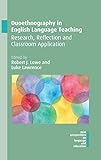Duoethnography in English Language Teaching : Research, Reflection and Classroom Application / ed. by Robert J. Lowe, Luke Lawrence.
Material type: TextSeries: New Perspectives on Language and EducationPublisher: Bristol ; Blue Ridge Summit : Multilingual Matters, [2020]Copyright date: ©2020Description: 1 online resourceContent type:
TextSeries: New Perspectives on Language and EducationPublisher: Bristol ; Blue Ridge Summit : Multilingual Matters, [2020]Copyright date: ©2020Description: 1 online resourceContent type: - 9781788927185
- 9781788927192
- Culturally relevant pedagogy
- English language -- Study and teaching -- Foreign speakers
- English language -- Study and teaching -- Research -- Methodology
- English language -- Study and teaching -- Japan
- Ethnology -- Methodology
- Narrative inquiry (Research method)
- Qualitative research -- Methodology
- LANGUAGE ARTS & DISCIPLINES / Study & Teaching
- critical applied linguistics
- duoethnography
- peer interaction
- qualitative research
- reflective practice
- research methodologies
- 428.0071/052 23
- online - DeGruyter
| Item type | Current library | Call number | URL | Status | Notes | Barcode | |
|---|---|---|---|---|---|---|---|
 eBook
eBook
|
Biblioteca "Angelicum" Pont. Univ. S.Tommaso d'Aquino Nuvola online | online - DeGruyter (Browse shelf(Opens below)) | Online access | Not for loan (Accesso limitato) | Accesso per gli utenti autorizzati / Access for authorized users | (dgr)9781788927192 |
Frontmatter -- Contents -- Contributors -- Foreword -- 1. An Introduction to Duoethnography -- Part 1: Duoethnography for ELT Research -- 2. Not all Eikaiwas (or Instructors) are Created Equal: A Trioethnography of ‘Native Speaker’ and ‘Non-native Speaker’ Perspectives on English Conver sation Schools in Japan -- 3. Critical ELT in Japan: A Duoethnographic Exploration of Origins, Identities, Obstacles and Concerns -- 4. Personalisation and Professionalism: Managing the Relationship Between Teacher and Learner as People -- Part 2: Duoethnography for Reflection and Teacher Education -- 5. Professional Development Through Duoethnography: Reflecting on Dialogues Between an Experienced and Novice Teacher -- 6. Puzzling about Special Educational Needs in EFL Teacher Development: A Duoethnographic Inquiry -- 7. Developing Understandings of Reflective Practice and Teacher Training -- Part 3: Duoethnography for Language Teaching -- 8. Duoethnography in the Language Class -- 9. Language Development Through Duoethnographic Peer Interaction -- 10. Collaboration and Cohesion: Using Duoethnography to Enhance Group Dynamics and Pair Relationship Building in a University Speaking Class -- Epilogue: New Directions for Duoethnography in ELT -- Index
restricted access online access with authorization star
http://purl.org/coar/access_right/c_16ec
This book sets out duoethnography as a method of research, reflective practice and as a pedagogical approach in English Language Teaching (ELT). The book provides an introduction to the history of duoethnography and lays out its theoretical foundations. The chapters then address duoethnography as a research method which can be used to explore critical and personal issues among ELT teachers, discuss how duoethnography as a reflective practice can aid teachers in understanding themselves, their colleagues or their context, and demonstrate how duoethnography can be used as a pedagogical tool in ELT classrooms. The chapters are a range of duoethnographies from established and emerging researchers and teachers, which explore the interplay between cultural discourses and life histories with a focus on ELT in Japan.
Mode of access: Internet via World Wide Web.
In English.
Description based on online resource; title from PDF title page (publisher's Web site, viewed 25. Jun 2024)


